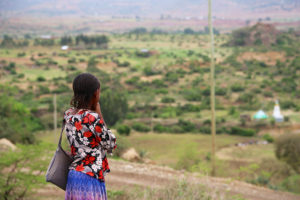Seed diversity vital to achieve landscape restoration pledges
- From
-
Published on
14.12.18
- Impact Area

Optimally achieving forest landscape restoration – and its associated benefits for ecology and human wellbeing – requires high-quality planting material.
Restoration plays a key role in sustainable development. With countries making significant pledges under the Bonn Challenge to restore degraded land, achieving these objectives at scale requires integrated systems that provide diverse, adapted and high-quality native tree seeds and planting material. However, there remains a gap in capacity, as studies have documented that the quality and quantity of tree germplasm is not always adequately addressed in restoration projects. Research is now generating solutions to help the global community move from pledges to impact when it comes to tree seeds and seedlings.
Photo credit: A woman looks out over an FLR area in Ethiopia. Photo by Mokhamad Edliadi/CIFOR
Related news
-

From Dirt to Decision-Making: Governance and Soil Health Must Go Hand in Hand
Multifunctional Landscapes Science Program26.11.25-
Biodiversity
-
Environmental health
-
Environmental health & biodiversity
In October, the world convened in Des Moines for the 2025 Borlaug Dialogue under the…
Read more -
-

ICRISAT’s Solar-Powered Water Hyacinth Harvester Recognized Among India’s Top 100 Innovations of 2025
International Crops Research Institute for the Semi-Arid Tropics (ICRISAT)18.11.25-
Environmental health
-
Poverty reduction, livelihoods & jobs
ICRISAT's Novel Solar-Powered Water Hyacinth Harvester has now earned a place in the prestigious To…
Read more -
-

CGIAR Multifunctional Landscapes at COP30: Advancing Adaptation and Nature-Based Solutions
Multifunctional Landscapes Science Program10.11.25-
Adaptation
-
Biodiversity
-
Environmental health
-
Environmental health & biodiversity
-
Mitigation
COP30 in Belém, Brazil is being heralded as a pivotal “COP of adaptation” and a…
Read more -
